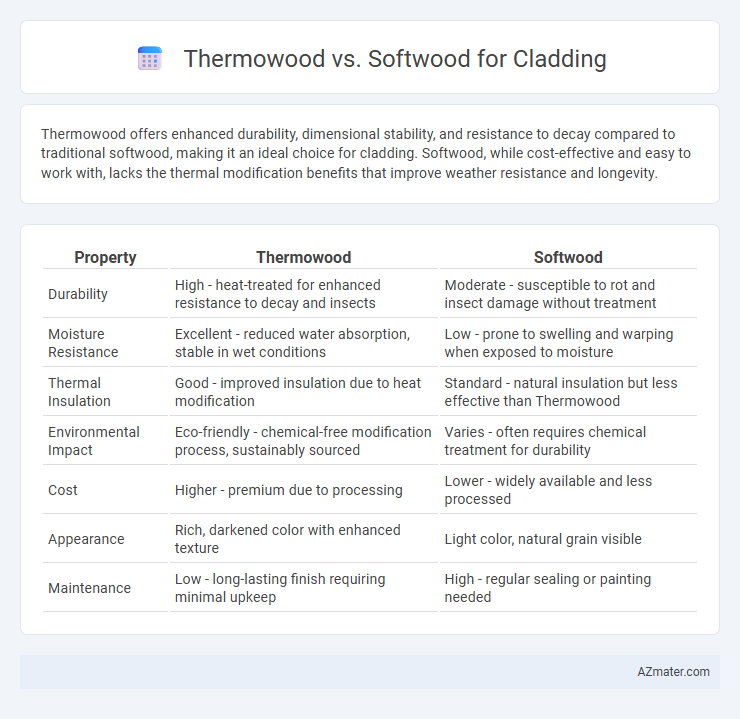Thermowood offers enhanced durability, dimensional stability, and resistance to decay compared to traditional softwood, making it an ideal choice for cladding. Softwood, while cost-effective and easy to work with, lacks the thermal modification benefits that improve weather resistance and longevity.
Table of Comparison
| Property | Thermowood | Softwood |
|---|---|---|
| Durability | High - heat-treated for enhanced resistance to decay and insects | Moderate - susceptible to rot and insect damage without treatment |
| Moisture Resistance | Excellent - reduced water absorption, stable in wet conditions | Low - prone to swelling and warping when exposed to moisture |
| Thermal Insulation | Good - improved insulation due to heat modification | Standard - natural insulation but less effective than Thermowood |
| Environmental Impact | Eco-friendly - chemical-free modification process, sustainably sourced | Varies - often requires chemical treatment for durability |
| Cost | Higher - premium due to processing | Lower - widely available and less processed |
| Appearance | Rich, darkened color with enhanced texture | Light color, natural grain visible |
| Maintenance | Low - long-lasting finish requiring minimal upkeep | High - regular sealing or painting needed |
Introduction to Thermowood and Softwood Cladding
Thermowood is a heat-treated wood that enhances durability, stability, and resistance to decay, making it an ideal material for exterior cladding in various climates. Softwood cladding, commonly sourced from pine, spruce, or fir, offers natural insulation properties and a cost-effective option but requires protective treatments to improve weather resistance and longevity. The thermal modification process of Thermowood reduces moisture absorption, resulting in less warping and cracking compared to untreated softwood, ensuring a longer-life cladding solution.
Key Differences Between Thermowood and Softwood
Thermowood is heat-treated softwood, enhancing its durability, dimensional stability, and resistance to decay compared to untreated softwood. The thermal modification process reduces moisture absorption and improves resistance to fungal decay, making Thermowood ideal for exterior cladding applications. Softwood, while cost-effective and readily available, lacks the enhanced longevity and weather resistance of Thermowood, requiring more maintenance in outdoor environments.
Durability and Longevity Comparison
Thermowood offers significantly enhanced durability and longevity compared to traditional softwood due to its heat treatment process, which reduces moisture content and increases resistance to decay and insect attacks. Softwood, while commonly used for cladding, is more susceptible to rot, warping, and weather-related damage without proper treatment. Thermowood's stability and lifespan make it a superior choice for outdoor cladding applications where long-term performance is critical.
Weather Resistance and Performance
Thermowood cladding offers superior weather resistance compared to traditional softwood due to its heat treatment process, which enhances dimensional stability and reduces moisture absorption. This treatment increases the wood's durability against rot, decay, and insect attacks, making it ideal for exterior applications in harsh climates. Softwood, while cost-effective and lightweight, generally requires additional protective coatings to achieve similar weather resistance and longevity.
Aesthetic Appeal and Color Stability
Thermowood offers superior aesthetic appeal compared to softwood due to its rich, warm tones and enhanced grain definition created through controlled heat treatment. This process also significantly improves color stability by reducing the risk of fading and weather-induced discoloration over time, ensuring a consistent and attractive appearance. Softwood, while initially vibrant, tends to lose its color and develop a weathered gray patina faster without protective coatings or treatments.
Environmental Impact and Sustainability
Thermowood cladding offers enhanced environmental benefits by using sustainable Nordic softwood treated through a natural thermal modification process that reduces chemical usage and increases durability, extending the product's lifespan and lowering replacement frequency. Softwood cladding, while renewable and widely available, requires chemical preservatives for longevity, which can introduce environmental toxins and reduce biodegradability. Choosing Thermowood supports sustainable forestry practices and reduces carbon footprint due to its longer service life and lower maintenance needs compared to untreated softwood.
Cost Analysis: Thermowood vs Softwood
Thermowood cladding typically incurs higher upfront costs compared to softwood due to its specialized heat treatment process enhancing durability and stability. Softwood, while more budget-friendly initially, may require more frequent maintenance or replacement over time, potentially increasing long-term expenses. Evaluating lifecycle costs reveals Thermowood often provides better value in harsh climates, balancing initial investment with reduced upkeep and extended lifespan.
Installation Process and Maintenance Needs
Thermowood cladding offers a more stable and durable installation process due to its enhanced dimensional stability and resistance to moisture compared to traditional softwood, resulting in fewer alignment issues and faster fitting. Softwood cladding requires careful handling and additional treatments during installation to prevent warping and decay over time. Maintenance needs for Thermowood are significantly lower, as its thermal modification reduces susceptibility to rot and insect damage, whereas softwood cladding demands regular sealing, staining, or painting to maintain appearance and structural integrity.
Common Applications in Modern Architecture
Thermowood offers enhanced durability and moisture resistance, making it ideal for exterior cladding in modern architecture, especially in wet or humid climates. Softwood, such as pine or spruce, is commonly used for interior cladding and decorative facades due to its affordability and ease of construction. Architectural projects that demand longevity and low maintenance frequently opt for thermally modified wood, while softwood remains popular for budget-conscious designs and sheltered applications.
Choosing the Right Cladding: Thermowood or Softwood?
Thermowood offers superior durability, enhanced dimensional stability, and improved resistance to decay compared to traditional softwood, making it ideal for long-lasting cladding applications. Softwood, such as pine or spruce, is cost-effective and readily available but requires regular maintenance and treatment to withstand weather exposure. Selecting Thermowood over softwood can reduce maintenance costs and extend the lifespan of exterior cladding, especially in harsh climates.

Infographic: Thermowood vs Softwood for Cladding
 azmater.com
azmater.com